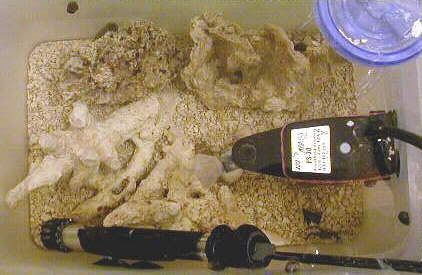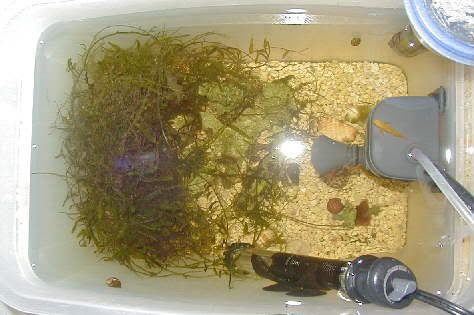I realize my picture quality stinks and probably always will until I get a new camera, but I thought this particular set of pictures was interesting for charting the developement of my 5-gallon pico with a "Caulerpa forest". I also realize my tank is probably the definition of ugly to many people, but hey, it's functional lol. My goal was to try to reproduce a non-reef tidal-type setup with some sort of thick vegetation and attempt to get my snails to spawn regularly and have surviving offspring. It's been a big success, and I have a pretty much non-stop production of snail eggs that hatch. My next challenge is getting the right types of microalgae growing that the young snails wille eat. I've seen some hatchling-size snails appear periodically that must have undergone the veliger stage successfully, but I havn't seen anything indicating they are surviving past that stage yet--probably because their prefered food is scarce. I'm working on getting a nice carpet of soft micro algae going on the sides.
Last year:

Not much interesting happening...just Nerites and veliger larvae from them periodically. I think there was one margarita snail in there.
Later when I added the Caulerpa:

Following this pic was when I really struggled getting any nitrate output to have the Caulerpa grow. My clown goby was the only thing that fixed that problem.
Today (excuse the flash...can't get as good a lighting as before):

Rocks were re-arranged to maximize substrate surface area for other snails and provide a better growing surface on the opposite side for the Caulerpa. Most of the rocks are hidden by the Caulerpa growing from the back and "leaning over" the rocks in the current. You can see my goby sitting on the powerhead...Other animals include some small conch species, a hermit, bristleworms, and vertmetid snails. I know the Caulerpa looks excessive, but it's reached a stable point where if I don't trim it, it doesn't grow outwards much past that. There are always snails crawling around inside it, and contrary to what I would have thought to be possible with the goby in there, I have a small pod population! The water is always perfect, and its even lower maintenance than my freshwater tanks at this point.
Last year:

Not much interesting happening...just Nerites and veliger larvae from them periodically. I think there was one margarita snail in there.
Later when I added the Caulerpa:

Following this pic was when I really struggled getting any nitrate output to have the Caulerpa grow. My clown goby was the only thing that fixed that problem.
Today (excuse the flash...can't get as good a lighting as before):

Rocks were re-arranged to maximize substrate surface area for other snails and provide a better growing surface on the opposite side for the Caulerpa. Most of the rocks are hidden by the Caulerpa growing from the back and "leaning over" the rocks in the current. You can see my goby sitting on the powerhead...Other animals include some small conch species, a hermit, bristleworms, and vertmetid snails. I know the Caulerpa looks excessive, but it's reached a stable point where if I don't trim it, it doesn't grow outwards much past that. There are always snails crawling around inside it, and contrary to what I would have thought to be possible with the goby in there, I have a small pod population! The water is always perfect, and its even lower maintenance than my freshwater tanks at this point.




 (2 on the stalk closest to the camera)
(2 on the stalk closest to the camera)

 wouldn't be great for corals, but for non-coral stuff it has done well!
wouldn't be great for corals, but for non-coral stuff it has done well!